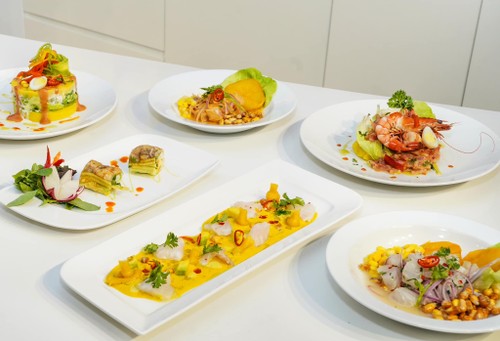 A number of Peruvian dishes introduced at the launch ceremony of the gastronomic week (Photo credit: Peruvian Embassy in Vietnam) A number of Peruvian dishes introduced at the launch ceremony of the gastronomic week (Photo credit: Peruvian Embassy in Vietnam)
|
Vietnamese gastronomes were recently treated to the diversity of Peruvian cooking through the performance of guest chef Jose Maria Murga Brescia during a Peruvian gastronomic week held in Hanoi recently.
Peruvian Ambassador to Vietnam Augusto Morelli says Peruvian cuisine reflect the country’s tradition and culture.
In a talk with VOV, he elaborated on the most typical characteristics of Peruvian cuisine, “Actually, Peruvian food is a fusion of Peruvian traditions, the pre‑Columbian tradition, before the Spanish, that is combined with the European, Chinese, and Japanese styles.”
The ambassador took the tradition of ceviche for example, which focuses on the fish. Japanese have a lot of fish because of their cold waters.
Talking about Peruvian cuisine, it’s impossible not to mention the geographical conditions which are believed to make Peru’s cuisine so unique, said Ambassador Augusto Morelli.
“This is a direct relation between Peru’s geography and the production of food. For example, along our coast, there is a desert because the cold current of the sea that came from the Antarctic to the north, from south to north, we have the Humboldt current, they call it, that is very cold, so we have a lot of fish. That means that fish was part of the natural diet of all the cultures along the coast. In the highlands, because of the altitude you have different products depending on the level where it is produced,” the diplomat said.
Another example, Ambassador Augusto Morelli said, is in the Amazon where you have all kinds of products.
“But food, altitude, geography, deserts, the Amazon, they are all related. And now we are working to put these fantastic products out to the world. They are called superfoods. We produce a lot of superfoods and in Vietnam you can find the same thing,” Mr. Augusto Morelli said.
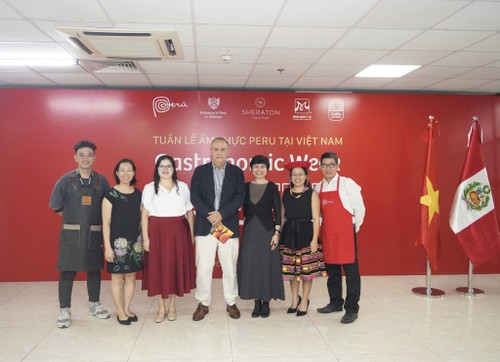 Peruvian Ambassador to Vietnam Augusto Morelli (C) at the launch of the Peruvian gastronomic week in Hanoi (Photo credit: Peruvian Embassy in Vietnam) Peruvian Ambassador to Vietnam Augusto Morelli (C) at the launch of the Peruvian gastronomic week in Hanoi (Photo credit: Peruvian Embassy in Vietnam) |
Anyone who has ever tried Peruvian dishes is impressed that almost all dishes of Peru are made from potatoes or served with potatoes. As the birthplace of the potato, Peru’s Instituto Peruano de la Papa (or Peruvian Potato Institute) estimates there are more than 3,000 varieties grown on home soil. They come in all shapes and colors, and more importantly, are genetically unmodified.
“What we call the domestic potato, is a potato that comes from Peru. Because potatoes in general come from the highlands of South America, in Colombia, Ecuador, Peru, Bolivia, the north of Chile, actually in the north of Argentina as well, potatoes are frequently used,” the Peruvian Ambassador said, adding, “But domestic potatoes come from the highlands of Peru. Historically, the potato then spread throughout Europe because of the European conquest.”
Another delicacy found in the Peruvian cuisine is recipes using guinea pig, known as “cuy” in Spanish. Seasoned with spices and grilled on an open fire, guinea pig has been a specialty of the Andes people for a long time.
This has raised a few eyebrows in communities where the animal is seen as a pet, but most Peruvians do not consider it any different from pork or beef.
“The “cuy” is a very important protein food. Maybe in some parts of the world, you don’t eat it. Maybe in others, they eat some kind of food like this. It’s a matter of culture. You eat this in the south of Peru, not much in the north. It’s a regional dish. You eat it like you eat chicken. You can grill it. It’s said it’s a white meat, very nice, very soft,” said the Ambassador.
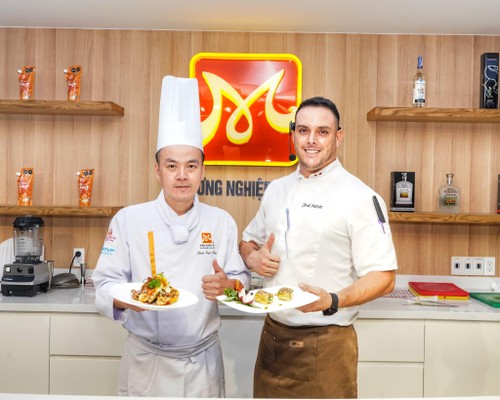 Vietnamese chef Pham Ngoc Dung and Peruvian chef Jose Maria Murga Brescia (Photo credit: Peruvian Embassy in Vietnam) Vietnamese chef Pham Ngoc Dung and Peruvian chef Jose Maria Murga Brescia (Photo credit: Peruvian Embassy in Vietnam)
|
At the Peruvian gastronomy week in Hanoi recently. Vietnamese chef Pham Ngoc Dung, a teacher of Asia-Europe Vocational Training Center in Hanoi, and Peruvian chef Jose Maria Murga Brescia together prepared and created a dish called “Grilled seafood spring rolls with Peruvian sauce”.
Chef Brescia said his excellent coordination with chef Dung helped them create a fusion dish with balanced flavors and a beautiful presentation.
“Chef Dung and I have prepared a dish that embodies the confluence of Vietnamese and Peruvian cuisines. We mainly use the materials which I find Vietnamese people often use in their daily meals like seafood and vegetables of different kinds. These are marinated with Peru’s specific sauce, the “anticuchos”. The main ingredients of the sauce include Panca red pepper, a typical type of pepper in Peru, combined with other common spices,” said Brescia.
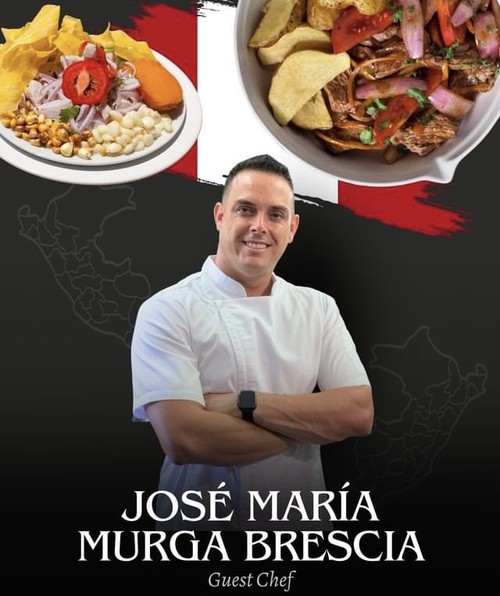 (Photo credit: Peruvian Embassy in Vietnam) (Photo credit: Peruvian Embassy in Vietnam) |
Chef Dung himself was impressed with Peruvian agriculture and the country’s cuisines where he found many similarities to Vietnamese food.
With a wide coastline, Peru has lots of seafood like Vietnam. Its agriculture has developed strongly like Vietnam, said Dung, adding if Peruvians have a lot of corn, and particularly potatoes of various types, Vietnam has many aromatic herbs which help balance the flavor of Peruvian dishes.
Dung took Peru’s sauce, “anticuchos”, as an example, adding, “It is a combination of lemon and their Pisco wine, making it a bit spicy which is suitable to the taste of Vietnamese people. The sauce which has a typical sweetness of Peruvian chili can be used to marinate beef, seafood, chicken, or pork, giving quite a delicious taste, similar to Vietnamese grilled dishes. The combination brings out the taste of both Peruvian and Vietnamese elements.”
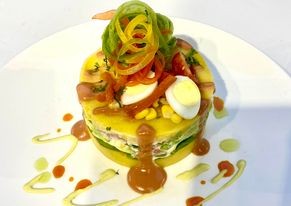 Causa Rellena, a Peruvian layered potato dish (Photo: Bao Tram) Causa Rellena, a Peruvian layered potato dish (Photo: Bao Tram)
|
When talking about Peruvian cuisine, it’s impossible to overlook the three famous dishes beginning with fresh ceviche seafood salad. These are “Tiradito”, a raw fish dish, “Lomo Saltado”, a traditional stir‑fried beef, and mashed Peruvian potatoes called “Causa Limeña”, along with two traditional beverages – Pisco Sour and Chilcano.
In addition, when visiting this enchanting country, desserts are also a staple of Peruvian cuisine and you should try including sweet potato donuts and anise-scented pumpkin Picarones.